After some research, we finalized on the following itinerary:
• Day-1: Drive to TalaCauvery. Upon return, touch Bhagamandala, Abbey Falls, Raja Seat. Rest for the night.
• Day-2: Drive to Dubare Elephant Camp and chill out
• Day-3: Finish the Elephant Interaction, Coracle Ride, visit Bylakuppe, and hit Bangalore by evening.
Day-1:
We started the day quite early. 0545 hours, we rolled from Outer Ring Road, near Intel (Marathahalli), Bangalore. We had planned to have our breakfast at Kamat’s. By 0620, we had reached the Mysore Toll plaza (Toll charges 20 rupees) at Kanakpura Road for the NICE Road leading to Mysore Road. The NICE road was a breeze. There was minimal traffic as well on the Mysore road. My kid, Sonakshi (all of 3 years of age) was mega kicked about the whole trip because she is being taught about animals and jungles and that we were going to a jungle to meet the elephants was keeping her happy. She kept us entertaining all through the trip with her rhymes…
Kamat came quicker than expected. 66.5 KM and 0705 hours. A new welcome addition there is the Buffet Breakfast costing INR 80.00 per plate. We realized that our good breakfast also came to the same price per head. We could have taken the Buffet instead. Post breakfast, once on the way by 0745 hours, we wanted to make the short-cut through the Ranganthittu Bird Sanctuary road rather than the road via Mysore. Good folks in Team-BHP had discovered this and had recommended. We followed the directions and after the board which says “Thank you for visiting Srirangapatna” at 0900 hours / 142 KM, we took the right turn towards Ranganthittu Bird Sanctuary. The road was narrow and because of the rains the road has gone bad in some stretches now, but definitely drivable.
At the end of this road, one encounters the V-junction to enter the SH-88. SH-88 is a smooth ride. From then on, Hunsur (1000 hours/ 190 KMs), Piriyapatna (1015 hours/ 210 KMS), Bylakuppe (1040 hours/ 228 KMS), Kushal Nagar (1050 hours/ 232 KMS), Madikeri (1130 hours/ 263 KMS). The road from Bylakuppe/ Kushal Nagar to Madikeri is rough now and there was traffic. In fact, as we entered the Madikeri town, just before the Madikeri Bus station, there was a big jam. From this junction, one needs to take a left to Bhagamandala and Talacauvery.
The weather was lovely. The sun and the clouds were playing hide and seek. One side of the road was populated and on the other side of the road were very very tall trees. I had not seen these types of trees earlier. Mostly, I felt that these trees were the natural support for the black pepper creepers. We thought the drive would be really smooth. And it was mostly. The steep S-bends were taking the toll though-on speed and energy. At some stretches, it was boring also to see the same endless view. You can imagine the drive to Talacauvery because we took 1.5 hours to cover a distance of around 40 KMS. 1300 hours/ 306 KMS.
Finally after those endless curves, Talacauvery was a welcome beautiful sight. The cleanliness of the place was what struck us at the first glance. I was expecting fog around the place because they say that this place is so cool that most of the times this is foggy around 1200 hours as well. Plus, since I had seen the prettiness of the fog-covered temple in one of my photographer colleagues work (http://www.flickr.com/photos/sow/1196424164/), I was slightly disappointed to see that there was no fog there even though it was pretty chilly from the rain. But the rain had cleaned up the dust and the view was very clear. It was a Friday and hence the crowd was also very less. The temple has been maintained very well.
From Wiki: Talacauvery, is the place that is generally considered to be the source of the Cauvery River. It is located in the Brahmagiri hill (not to be confused with the Brahmagiri range further South) near Bhagamandala in Kodagu district, Karnataka, 1,276 m. above sea level. However, there is not a permanent visible flow from this place to the main rivercourse except during the rainy season. A tank or kundike has been erected on a hillside, at the place that is said to be the origin. It is also marked by a small temple, and the area is frequented by pilgrims. The Kaveri River originates as a spring feeding this tank, which is considered to be a holy place to bathe on special days. The waters are then said to flow underground to emerge as the river some distance away. The temple has been renovated extensively by the state government recently [2007].
On Tulasankramana day (the first day of Tula Masa month, according to the Hindu calendar, which normally falls in mid October) thousands of pilgrims flock to the river's birthplace to witness the rise of the fountainhead, when water gushes up from the spring at a predetermined moment. The tula snanam (Sacred bath in the Tula month) is observed across pilgrim towns in Kaveri's banks.
The temple here is dedicated to Goddess Caveriamma. Other deities worshipped here are Lord Agastheeswara, which denotes the link between Cauvery and Sage Agasthya and Maha Ganapathi.
The legend goes that, the Cauvery river was held in a Kamandalu (a container of sacred water) by Sage Agasthya. Vinaayaka (Lord Ganesha) took the form of a crow and perched on the kamandalu of Agasthya when Agasthya was meditating. When Agasthya realised this, he shooed away the crow. But the Divine Crow tipped the kamandalu and toppled it. Out poured Cauvery, which started flowing. The crow disappeared and in its place stood a small boy. Agasthya thought that the boy was playing some prank and clenching both his fists went to pound the head of the small boy. But the boy escaped and Agasthya gave chase. Finally the boy vanished and Lord Ganesha showed Himself to Agasthya. Agasthya was aghast at the realisation that he had just tried to knock the head of Ganesha Himself. As atonement, he knocked his own head with both of his clenched fists. (More details can be found @ http://en.wikipedia.org/wiki/Talakaveri )
TalaCauvery Temples:
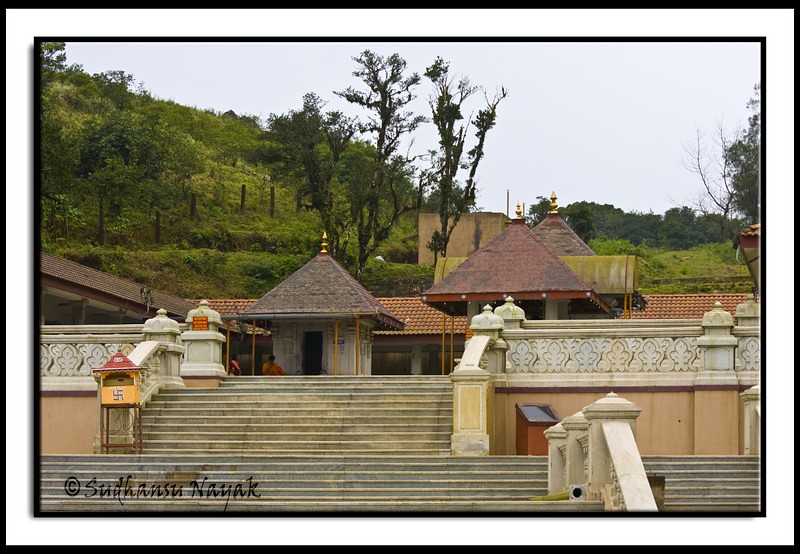
Points to note about the temple visit:
1. Photography and videography is prohibited for the temple premises but it is not strongly imposed. One can sneak in some photos.
2. There are two water bodies in the lower part of the temple where Cauvery has originated. One is a small 2 feet by 2 feet tank just in front of a small temple dedicated to Caveriamma. This water is supposed to be holy water and is not to be touched other than the priests.
3. However, there is an approx. 10 Feet by 10 feet water body next to it and people actually go inside without dresses to take a dip in this water. Water is cold (about 80 degrees F).
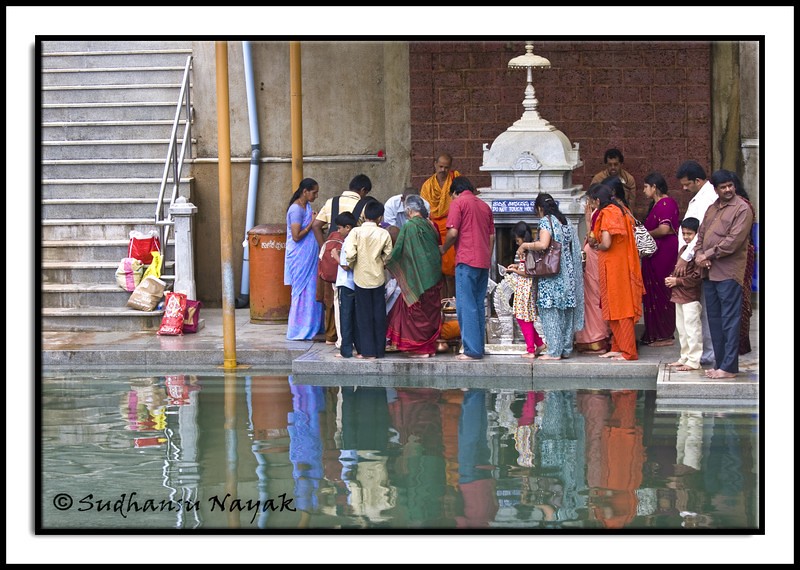
4. From here the water is siphoned off to a lower level and the water vanishes beneath the temple and is said that the next view is at Bhagamandala where Cauvery meets two other rivers called Kannike and a mythical underground stream called Sujyoti.
5. There is a changing room close to that separately for ladies and gents.
6. Prasadam is available in small packets which costs about 10 rupees.
7. A flight of stairs beside the temple will take one onto the top of the hill from where the view is breathtaking. But the stairs are steep and the wind speed on the top of the hill is high. Not recommended for children and elderly.
Cauvery is a raging torrent downstream and when one compares that force to the one near the origin, it is an amazing contrast. We couldn’t believe that such force can be bestowed by nature on something some humble at the origin. There is a small temple just outside Talacauvery. It is in dilapidated state now but looks interesting. Seemed like a recent addition.
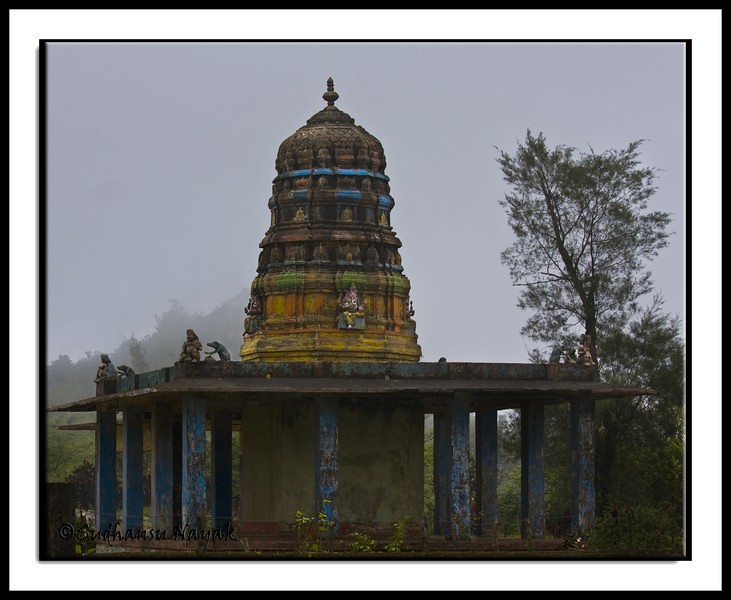
I was mega-kicked about this visit because for the first time in my life I was seeing the origin of any river.
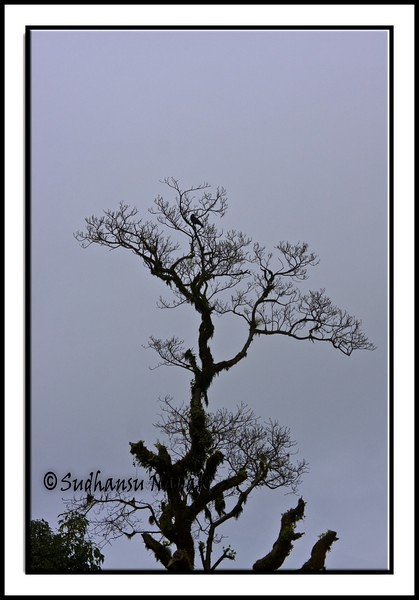
I was already raining while we started from TalaCauvery. Our next destination was Abbey Falls and we were apprehensive about it because it was not recommended to visit Abbey Falls when it rains heavily. We started around 1345 hours. On the way back, there was this beautiful view of the AIR, Madikeri. The fog was giving an impression that the tower is just hanging on there in mid-air.
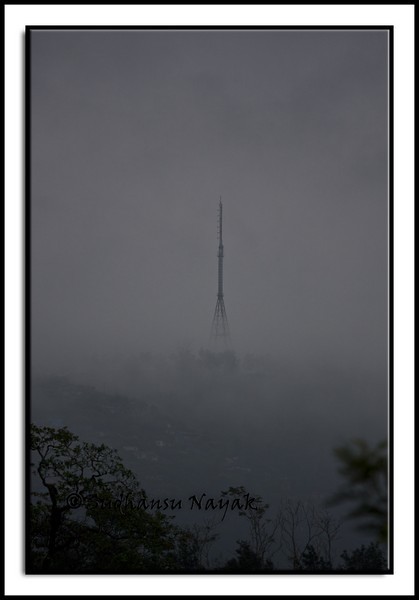
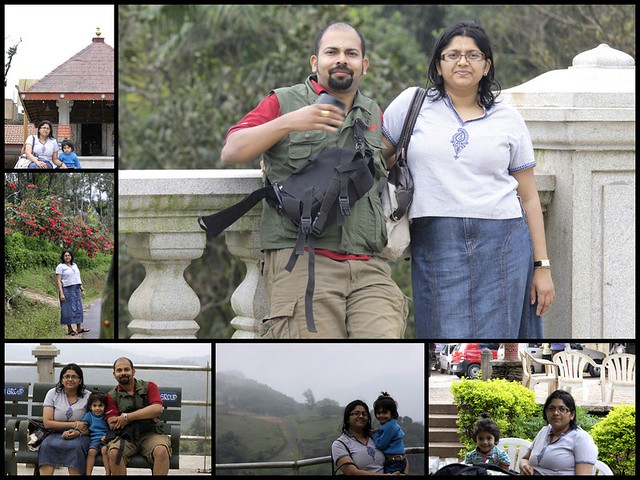
It was raining heavily already on the way and so we decided to have lunch in the Madikeri Busstop at a decent place. There is this vegetarian restaurant called Athithi Restaurant jus close to the Bus-stand and serves ok stuff. We wanted to wait till the rains stop but since it did not, we decided to make Abbey falls in the rain. Finally, @ 357 KMS/ 1700 hours, we reached Abbey falls.
Abbey Falls is located is a private coffee plantation. The falls appear suddenly combining forces of small stream during the monsoons and it is said this falls joins Cauvery downstream. There is a hanging bridge constructed just In front of the falls and very shaky. There is a Kali Mata temple on the other side of the bridge and Coffee and Black Pepper trees around.
This is small waterfall but looks lovely just post the monsoon. The best time to visit is early winter when the monsoons have brought plenty of water. It was raining heavily when we reached there but the view was good.
Points to note near Abbey Falls:
1. From Madikeri market, the falls are accessible by a narrow road to the coffee estate. This road is very narrow and slushy on the sides. Road is not maintained well. Drive needs to be calculated.
2. Cars are allowed until about 500 mtrs close to the falls. Entrance fees are 20 Rupees.
3. People travelling by bus will have to walk nearly 2-3 kms to reach the falls.
4. From near the entrance, there is a small walkway through coffee and cardamom plantations leads to the waterfalls. There are at least 50-60 stairs leading down to the falls. These stairs are covered with moss at places and is slippery. Care needs to be taken during the rains. The roar of the falls can be heard from the road parking.
5. The hanging bridge wobbles. So, care needs to be taken when children go onto the bridge.
6. There is a small cottage near the view point which gives instant photographs as well.
7. Photography and videography is allowed.
8. There is small tea/ coffee shop near the entrance gate to Abbey falls where we had tea. The tea was so-so.
By this time, we were completely drained and decided to call it a day. We had booked ourselves at Capitol Village. This place is deep inside the coffee and cardamom plantation and comes recommended. To reach, one has to reach Sudarshan circle in Madikeri, take the Siddapur road. After about 4-5 KMS on this road, Capitol village is on the right. After entering the mail gate, there is a fork some 10 mtrs ahead. For Capitol Village, one needs to take the one on the left.
Points to note about the place:
1. The road is slippery in the monsoons.
2. The rooms are good. We got a room in the second floor overlooking the valley. The view was good from the balcony.
3. It is not at all crowded. In fact, we were only the second family staying there for the night.
4. It was a bit scary in the evening and with all the gloomy weather around, the place resembled a set of Alfred Hitchcock movie set.
5. One can park close to the room. There are people to carry luggage upto the room.
6. The rooms are ok and we were not expecting much for 1500 rupees for a double room. The bathroom/ toilet could have been cleaner. We noticed that someone has plucked up the soap handles, towel handles from the walls. There were chip marks on the tiles.
7. Probably because of the low usage or the humidity, the beds and the blankets smelled a bit mildew-ish, but comfortable musty odor.
8. There were mosquito nets on the beds but strangely almost zero mosquitoes in the room.
We quickly checked for dinner and ordered food. The food was quickly prepared and served. We enjoyed the food on the balcony. It was a good feeling to enjoy hot chicken (roasted and tossed with fresh pepper) / rotis / rice/ dal / papad in a cold place on a balcony surrounded by long trees with open paddy fields where there were absolutely no one around and only sounds were that of crickets. The service was prompt. Even though there was no intercom, one could just call out to the manager and service was almost immediate.
The sleep was peaceful and long.
Day-2
View from Balcony of Capitol Village Room:

Next day morning, after solid cups of strong black coffee on our private balcony, we all started for a walk around the estate. It was filled with birds and the chirping coupled with the faint earthy smell was almost intoxicating. There is a small water body inside the plantation. I saw cardamom bushes for the first time in life there. Coffee was just coming up and we were told that they would ripen into red fruits by December time-frame. The chilled out morning was lovely and I spent unadulterated 3 hours with my family just lazily walking around soaking up all the nature around me.
Us-inside the plantation:

Varieties of flora around were also helping me teach my kid about loving nature. I am not sure how much she understood and absorbed but she loved the fact that the touch-me-nots were closing their leaves when she touches them. She took on a small project of actually identifying the small beauties and touching them for some time. The walkways were full of touch-me-nots. There were yellow grass flowers (almost miniature sunflowers) and other flowers around. I showed her how to fix flowers in the cutie small pony tail she had.
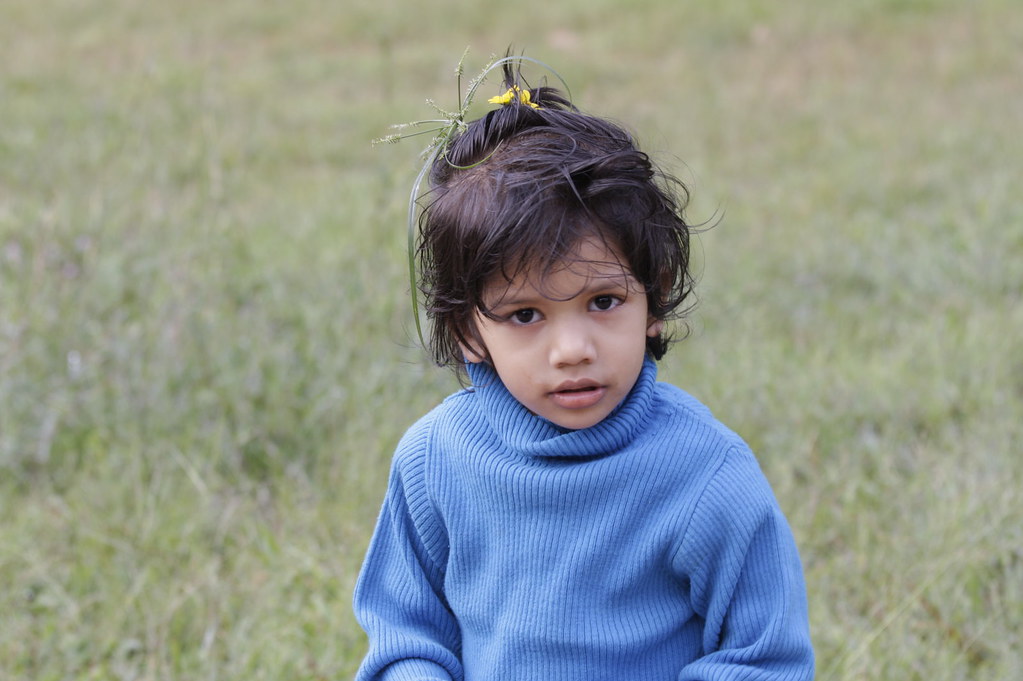
After a quick breakfast of Upma and chatni, we got ready for the day. The bill for the night with food came to 2000 rupees in Capitol Village. Since we had given Raja seat a miss the earlier day, we decided to make Raja’s seat before hitting Dubare Elephant Camp. So off we went around 1000 hours to Raja seat.
Raja’s Seat is a seasonal garden of flowers and artificial fountains around 2 kms from Madikeri Bus stand. A pleasant spectacle of refreshing layers of greenery, chain of high and low-rise-mountains attired with mist, the Raja Garden is one-time-favourites of Kings of Kodagu who use to watch the setting sun, and spend time with their queens here. The structure is small square in brick and mortar of four pillars bridged by arches, enhanced by beautiful surroundings. This lovely spot was a favourite place of recreation for the Rajas and hence was permanently associated with them. It is built on a high level ground with a commanding view of the cliffs and valleys to the west.
The entrance to the park is 10 rupees per head. There is also a toy train for the kids but it needs a minimum of 15 people to kick-start. My kid wanted to get into the toy train even before getting into the park around Raja Seat. Luckily, one big contingent of people suddenly landed near the toy train and we made it for the ride. It was kind of fun with the train going inside fake-tunnels, a shed, and a station named Cauvery Patna, I think. Just outside the station, there were bhelpuri shops and a guy selling the apparatus for making soap bubbles. My kid wanted the soap bubbles apparatus and freaked out with the bubbles. I had always seen the bubbles and had thought that the bubbles burst. But, Sonakhsi felt that the bubbles are going inside my palm when I was trying to hold them. This new perspective of looking at the bubbles from a child’s point of view was pleasantly refreshing.

Inside the park, there was a big sparrow population. These little cute birds are losing their habitat in Bangalore and fast. I had seen sparrows in Bangalore only in two places- Russel Market and Bangalore International Airport. Seeing the frolic of these sparrows added to mental peace. Raja seat also has variety of flowers and the place was beautiful. The view was also breathtaking.
At around 1115 hours, we started for Dubare Elephant Camp. For this, there are two routes- 14 KMS via Siddapur road or 28 KMS via Kushal Nagar. Since the Siddapur road was good, we took this one. We hit Sudarshan circle around 379 KMS and at around 390 KMS on the right side of the road there was this small waterfall from yesterday’s rain. We spent some time enjoying the small waterfall for some time.
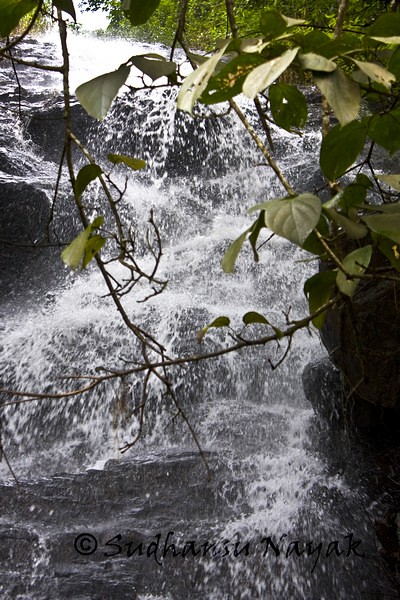
We crossed Chetalli (393 KMS) and hit Jungle Lodges and Resorts Cauvery Bank by 1250 hours. Some points for the people who book in Jungle Lodges and Resorts (JLR), Dubare:
1. To reach the resort, one will have to cross Cauvery. There is no bridge. It is supposed to be a big island (though soon I was to learn that there is a small jungle path that leads to Kushal Nagar from where the JLR guys get flash vegetable and fruits supplies. Otherwise the supplies of JLR come from Metro, Bangalore).
2. During summer months, there is not much water but during the monsoons, Cauvery carries around 50-60 ft depth of water and the water is really muddy and fast.
3. There are crocodiles in the water. So swimming is not recommended.
4. There are two places on the Cauvery Bank-one for the day trippers and one for the JLR campers. There is almost always a big crowd for the day trippers. For the JLR campers, the boat point is slightly ahead (about 50 mtrs). Reach there and check for the boatman. The parking for JLR is inside Dubare inn but the parking is allowed only when the JLR boatman accompanies you.
5. The price for JLR is 2500 per head per night inclusive of Lunch, dinner, breakfast, boat-rides, elephant interaction items, nature walk, morning safari, etc. More details here: (http://www.junglelodges.com/index.php?option=com_content&view=article&id=138&Itemid=102). If one books online, then you get a small discount.
6. Please book slightly in advance because there are limited seats in the cottages that are there.
7. No need to carry umbrellas because JLR provides.
The cottages are beautiful and the staff is cordial. Imagine: Staying on the banks of a river like Cauvery and with so few people. Hammocks around. Elephants munching on grass and lantana type shrubs. Trees all around with birds chirping. Light sun and shadow climate. The river gently flowing by. Touch-me-nots around and playing with them with my kid. Idyllic. Almost brings out the baby and philosopher in you. And that’s what happened ;-)
After a solid lunch with the Cauvery gurgling in the backdrop, I had a long sleep. Nice coffee afterwards, propelled me for a walk on the so-called island. We played with a puppy, touched more touch-me-nots, saw the elephants, and lazed on the hammocks. One of the elephants had to attend to nature’s call and huge lumps started to fall from the height and my kid remarks, “For potty, the elephant did not sit on the commode, neither did it wash or wear a pant…” and conclusion after that after a thought, “His papa or mama are not there, who will do it for him!!!” Gosh!!! Some workflows are so innocent that u can’t peg them to reason.

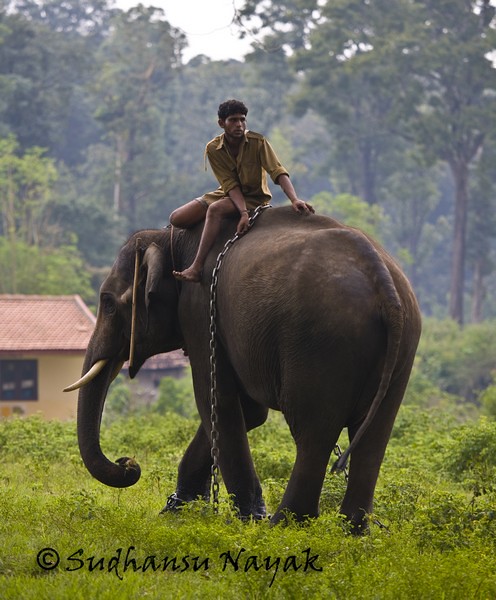
In the evening, they showed us a video on how tigers can be saved given that the rate at which the tigers are vanishing is so alarming. I am sure this was a good platform to show this video. I, for one, am very passionate about the “Save our Tigers” project and my resolve has increased after I became more knowledgeable on the same. Dinner was light and good. The sweet preparations @ JLR are amazing.
Day-3
Early in the morning, JLR took us for a Jungle Safari into the jungles but it was not so lucky for us. The majority of the jungle floor is covered with Lantana but for the spread of Lantana the bird populations is really low. Max types of birds that we saw are grey/ yellow wagtails, solitary Eagle Owl, some Malabar parakeets, pea-fowls, jungle fowls, crows and some sparrows. Among animals, we saw a family of jungle elephants only in the teak forests. They were very shy and wanted to avoid any disturbance. They had a 1-2 month old kid also with them. Well, after a not so eventful safari, breakfast was definitely a refresher. We were looking forward to the Elephant interaction program after that which included various activities like washing and scrubbing the elephant, watching it while feeding and finally a ride on the elephant. I had never done this in my lifetime thus far. It was amazing to see how the elephant enjoyed the scrub and the wash. We all had great fun in this. Sitting on the elephant is also an experience in itself.

Once done, we wanted to do it again…:-)
A Coracle fun ride awaited us. Once more- a first time for all of us. Recently we had watched Raavan (movie) and there was a good coracle scene in the movie. But sitting in the coracle and balancing all sides must have taken a lot of practice from the coracle driver. All in all -nice fun.
Next on agenda after leaving the Dubare elephant camp was Bylakuppe Nandroling Monastery.
As per Wiki: Bylakuppe is the location of "Lugsum Samdupling" (established in 1961) and "Dickyi Larsoe" (established in 1969), two adjacent Tibetan refugee settlements, as well as a number of Tibetan Buddhist monasteries. The Namdroling Nyingmapa Monastery (or Thekchog Namdrol Shedrub Dargye Ling) is the largest teaching center of Nyingmapa – a lineage of Tibetan Buddhism – in the world. The monastery was established by throne-holder Kyabje Penor Rinpoche in 1963, following his 1959 exit from Tibet as the second seat of the Palyul Monastery, one of the six great Nyingmapa Mother monasteries of Tibet prior to annexation.
The monastery's full name is Thegchog Namdrol Shedrub Dargyeling, called "Namdroling" for short. Its initial structure was a temple constructed from bamboo, covering an area of approximately eighty square feet. Namdroling Monastery hosts several ceremonies yearly. Of particular interest are Tibetan New Year (Losar), the timing of which approximately matches Mardi Gras in the West. The monastery hosts traditional Lama Dances, oversize Thankga hanging from the sides of its buildings, as well as solemn processions throughout the monastery grounds spanning approximately two weeks.
From the approach road to the monastery, the Golden Temple looks beautiful. We were not prepared for the beauty that lay within. The people there are very polite hosts.


The Triad:
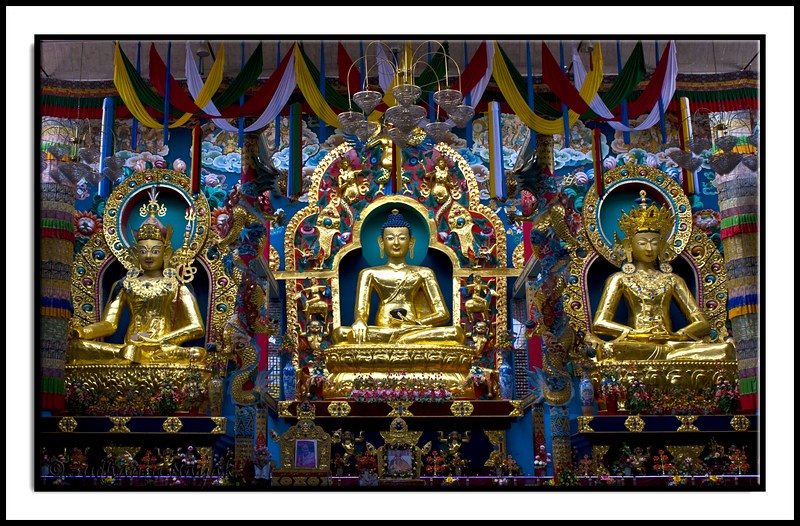
Guru Padmasambhava:
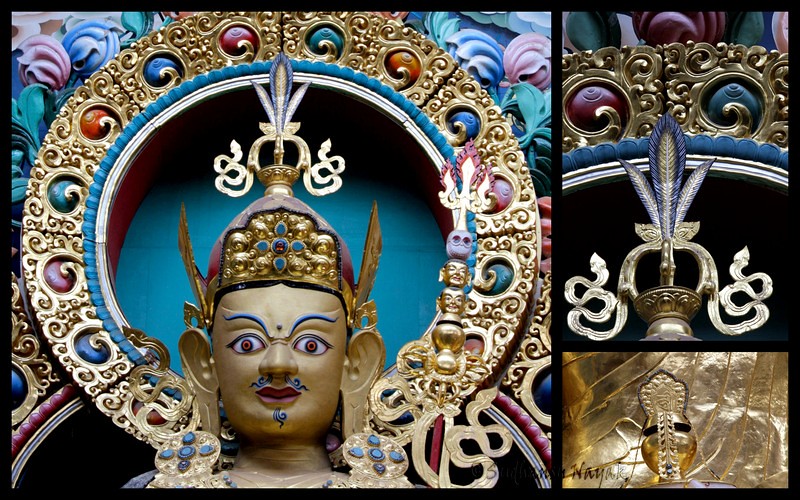
Crown of Guru PadmaSambhava:
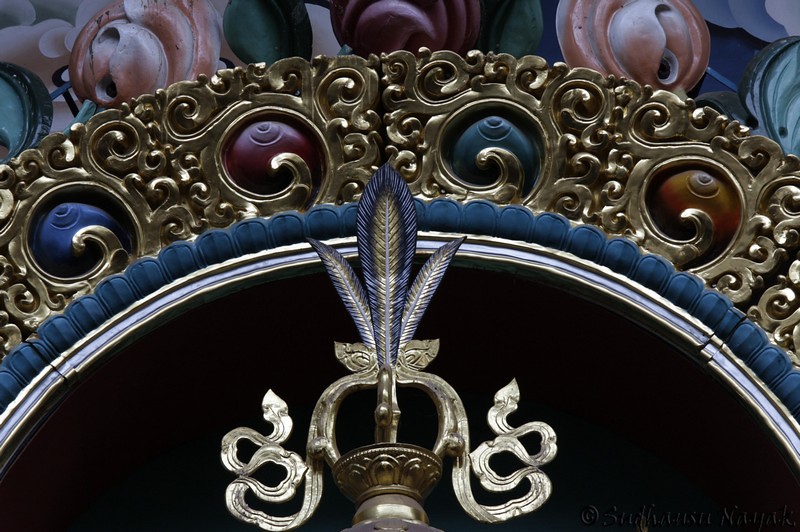
Guru Amitayus:

There is a small shopping cente there where we had some momos and then we headed for Bangalore around 1330 hours post lunch. While returning, we made good speed because it was sunny but we decide to give the shortcut through Ranganthittu a miss and go via Mysore just to get a feel of that road as well. The road via Mysore is a good 20 KMS, of good quality, around the Mysore city, almost same the distance through the Ranganthittu road but the minus point is there is more traffic than the shortcut.
Finally after a couple of stops on the road back to Bangalore, we reached home around 1900 hours. By that time the odo read 670 KMS. Car guzzled around 32 litres of petrol giving an average of 20 KMPL without AC. The service just before the trip helped.
Overall, this has been a memorable journey for us and extremely enjoyable. Hope you also loved the travelogue…and before I close for this blog, let me also quote from the net as to why is Coorg called the Scotland of India (http://cloudvalley.net/content-01D.html )
1. The British planter community was mostly Scots. It was they who affectionately called Coorg ‘The Scotland of India’ because of the many uncanny similarities.
2. Both Scotland and Coorg were cold, misty, mountainous regions. Both had potent local brews.
3. Both peoples thought of themselves as being very distinct from their neighbors. They loved their independence, their dances, rough sport, a good hunt and a fierce fight. The Scots and the Coorgs, stood their ground almost right through their history against vastly superior neighbouring kingdoms.
4. The Coorgs, like the Scots are divided into clans. There the Stuart and the MacLeary, here the Pattamada and the Kambiranda. The clans warred constantly in both lands, in the early days, fortunately clan memories are short and today there is complete peace.
5. Both the Scots and the Coorgs had, actually still have, a distinctive dress. Though worn on ceremonial occasions today - the knee length kilt and the knee length kupya, were designed for quick movement in wet, grassy hills.
6. A love of arms…while the Scots had their dirks (short daggers), the Coorgs had their peechekathis, carved, sheathed daggers which they kept tucked into the cotton cummerbunds, which held together the wraparound cloaks they wore.
7. If Scotland has the Highland Games, Coorg has its own flavour of the same. Rough and tumble contests, including the ritual sharp-shooting of coconuts placed on trees during the Festival of Arms. And what is probably the largest hockey tournament in the world. Over 300 clans compete for the Coorg Family Cup ever year.
8. Fittingly, many of the estates in Coorg have Scottish names. Names that roll off the tongue like the rain off the red tiled roofs. Names that remind you of childhood, of days gone by, when things were slow, gentle and perfect. Dalquarren, Craigmore, Dunkeld, Glenmore…sometimes the semi-Indian name like Coover Colly (‘colly’ means a ‘little pond’ here). Or the local but curious names like Nari Kad, meaning Tiger’s Forest. And Karadi Gud which means Bear Cave.
PS: Some more photograohs will be updated shortly...

Great travelogue Mr.Sudhansu Nayak , and nice photographs too!
ReplyDelete
ReplyDeleteGreat and easy-to-understand tutorial, thnx!
Distance Education Institute In Gurgaon
It was lovely reading your blog post. Also known as Kodagu and nicknamed as the "Kashmir of South", Coorg (Kodagu) is one of the precious gems in Karnataka's crown. Click here to know more about Coorg tourism.
ReplyDeleteGood blog
ReplyDeleteThis is your second blog i am reading and again an wonderful post. beautiful daughter and lovely pics of the family and the trip. Keep sharing the update.
ReplyDeleteBangalore to Coorg Cabs
This was amazingly and briefly explained post which i have ever seen. Loved reading this post.
ReplyDeleteWow very nice post about this lovely place. Loved reading this post, thanks for sharing this wonderful post. This blog really helps people to plan for trips. Pictures were awesome and this inspires readers to make their visit to this place. Want to explore this place, then book your bus tickets in advance in Online Bus Ticket Booking portal.
ReplyDeleteSettled among the interminable mountains that line the southernmost fringe of Karnataka is the shocking Coorg district, skilled with emerald paintings and sections of land of ranches.
ReplyDeleteAndaman holiday tour packages
Book budget hotels in port blair
Very nice post about your trip to Kodagu, wonderful place to explore during vacation. I used to visit this place very often. Thanks for sharing about this place. Love to travel this place, this is one of the top tourist destinations in India. If planning to travel Coorg, book bus tickets in Bus Ticket Booking portal.
ReplyDeleteIt was very nice of you to share your travel experience in your blog. We couldn’t help you in your travel experience. But in case any others in your circle need any package. Kindly contact us
ReplyDeleteMysore tour packages
I had seen your post that such a grateful blog and thanks for sharing your information.
ReplyDeleteOoty tours and travels | Car Rental in Coonoor